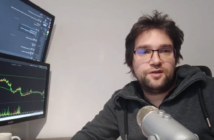You place an order and it turns out that it was only filled partly or somebody for a split of second overtook you gathering orders at better price. Did something like that happen to you?
For me it’s very often, which lead to damn irritation and suspicions, that somebody on the market knows more and is faster than me. What’s behind this “inequality”? It is so-called front running, about which you can read in the following article. I will present examples of front running taken from the real-life and ways how to deal with them.
What is Front Running?
It is worthwhile to explain ‘What is Front Running’ at the beginning. It’s good information for those, who just begin. This will help you understand occurrences on the stock market. At the same time will show that this problem affects everyone. Unfortunately!
Front running is use of information about incoming orders on the market, thanks to which the other side of the transaction forestalls the move redeeming shares earlier from the market. It is illegal for brokers, who can forestall orders of their customers by previously opening the position for themselves, but at worse price for the customer, in the process reselling earlier purchased shares. Another type of front running is use of classified information. A moment before publication of important information, the side which about the given news no longer buys shares / or trades for a short while. Closes own positions after publication of news, in the process generating profit.
Speed
The fact that somebody is faster than me doesn’t surprise me. My delay from Poland is on a level of 100-120 ms, while closest to the stock exchanges have a fraction of milliseconds or a few milliseconds scarcely in the case such as me – daytraders. If you read the book “Flash Boys”, probably you know how huge advantage provides the lead time of order to reach the market.
Hereinafter I will present examples of trading session, in which I was too slow. Not even me, but the lead time of order, its reaching to the market. Because of that my order was only filled partly, although constituted not even 1/50 of what was on the other side of quotes.
My definition of Front Running
In my definition it looks a bit differently. To the literary description I would add widely understood HFT traders. Literary description, a bit quarrels who on the market “cheats”. The most considerable problem with front running I can see between daytraders and HFT traders or persons using algos.
Of course, it doesn’t regard everyone mentioned above. You cannot, in fact, include all HFT/algos together. I won’t go deep into the differences between different HFT.
What is the biggest problem in front running, and which I feel in more or less painful way on the market?
Example how we lose with HFT/algos/broker
At the beginning I will present an example, which will be my reference point. Thanks to that you will be able to judge how it looks like in the scale of both my loss and total profit for algos.
Quite simple example:
-
Long position on the company.
-
Attempt to close the position at the price of .06$ with expected route in midpoint, if the algorithm which carries the order will be in a spread of other offers to buy.
-
After launching the order I notice that: for a split of second before my orders, exactly the same amount of shares was filled at the price of .0650$, and my orders are filled in a moment at the price of 0.0601$.
-
Conclusion: somebody overtook me and obtained better filling at the price of 0.0650$, and my order was filled at the worse price.
-
Of course, my order was carried out along with the order of the person who overtook me.
How it looks like from the side of loss/profit for me and for the other party of transaction?
By the fact that somebody overtook me at about 0.0049$, my lost was 0.49$ at 1000 shares. So much the other party of this order earned. It regards gross of course. You might say – what a loss. Sure! But I look at it in a scale of one session, week, month, year or a few years. And this amount grows significantly. During the week, such transactions happen to me 100 times. This is a total minimum.
100 * 0.49$ = 49$. In the month this amount increases to a minimum of 200$, in a year it’s a minimum of 2400$. It is already enough a significant amount, isn’t it? It would be enough for some holidays.
Look at it in the global scale
Look at the fact that this regards only my loss. I’m a single trader. Let us look again in a scale of thousands traders, which meets a similar fate. Then this amount grows to enormous sizes.
Who in such case is the other side of transaction?
There are two answers. One is a broker, who works to my disadvantage. Unethical, isn’t it? But such is reality. SEC combats this, but as can be seen ineffectively. The second group, which is responsible for this state of affairs, is a group of companies specializing in HFT and creating algos. Some of them uses differences between fillings among individual stock exchanges and is able to forestall my orders finding their way to one exchange.
How such a process proceeds?
I will describe it on the following recording. In the recording you will find out how the front running looks like and what forms it takes: both while closing positions and during an attempt to open positions.
To add english subtitles: on right down corner you add CC + english translation in settings (on youtube).
In the next section
In the next part of article I will describe how to deal with front running to a level which we control. I will also describe how my order is carried out, before it reaches the market and where the majority of algorithms are.
I hope that in the recording you’ll find valuable things. Would you like to hear something more?





